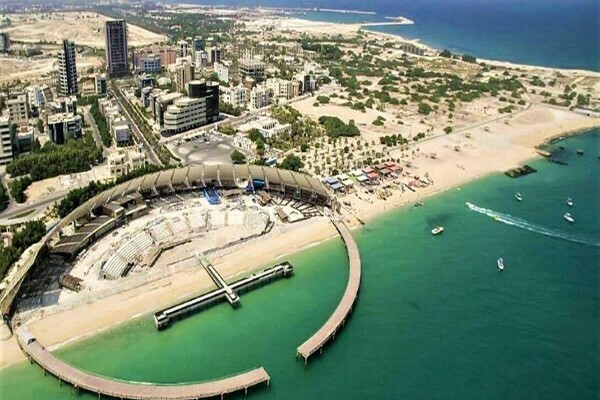Bandar Abbas
It is a port city and the capital of Hormozgan province, on the southern coast of Iran. The city dominates the Persian Gulf and occupies a strategic position in the Strait of Hormuz. The earliest traces of Bandar Abbas date back to the reign of Darius the Great (522-486). Darius’s commander, Silacus, sailed from Bandar Abbas to India and the Red Sea. During Alexander’s conquest of the Persian Empire, Bandar Abbas was known as Hormirzad.
Antiquities of Bandar Abbas
Suru Old Quarter
Located in the central part of Bandar Abbas county, in Hormozgan province. Many coins from the Sassanid, Safavid and Qajar periods were discovered here and are kept in the Bandar Abbas Museum. A total of 64 gold coins made by Moluk Hormoz and Jerun were discovered in the town of Godo in 1925. In the northern part of the Suru district, there were groves that until recently included thousands of date palms and other trees such as mesquite, the tamarisk and the euphoria. The inhabitants of Suru spend 3 months in these groves in summer. Suru Historic District, covering an area of 87 hectares, is the second largest in Bandar Abbas.
Khersin Salt Cave
There is a salt dome 3 kilometers on the northwestern side of Siahu. Its main part is made of salt, and it houses long salt caves. The dissolving shapes of the salt have created sumptuous shapes on the dome. Khersin Siahu Salt Dome is most famous for its salt waterfall and huge columns of salt, unique features compared to other salt domes in the province.
Berkeh Haye Baran
It is a complex that includes five water reservoirs linked to the Safavid era with wonderful stone and mortar domes. The lakes have four main openings for the exploitation of water. The freshwater reservoirs of Bandar Abbas would have been fed by these lakes in the past, where in the past there was a treatment plant that would have refined the water from the lake and the reservoir.
Hindu Temple
One of the most prominent historical monuments in Bandar Abbas, located on Imam Khomeini street, opposite the market. The building was constructed in 1892, during the reign of Mohammad Hassan Khan, the ruler of Bandar Abbas at the time. He had the temple built with Hindu offerings collected by Indian merchants. The building consists mainly of a square central hall with a dome above it. The architectural style of this dome distinguishes it not only from buildings on the shores of the Persian Gulf, but also from those throughout Iran. The design of this monument is totally inspired by Indian architecture.
Anthropological Museum of Bandar Abbas
It is located in the ancient Hindu temple of this city. Here the remains of the ancient civilizations of the coast and the surrounding islands are exposed. In addition, in this museum you can see old objects, such as local clothes and tools that were used for crafts. Ancient coins and relics found on Suru Hill are also on display here.
Kolah Farangi Palace
It is located in the central part of Bandar Abbas county and is one of the attractions of Hormozgan province in southern Iran.
Kolah Farangi is the oldest building in the city, dating from the Safavid era. This palace is located near the old port of Bandar Abbas. As this mansion is influenced by European architecture, it is known as Kolah Farangi, “Foreign Hat,” like many other palaces from the Qajar period.
Zaar ceremony
An anthropological ritual typical of the peoples of the Persian Gulf. The Zaar winds are believed to come from Ethiopia. The “Hawa” are the people affected by one of these winds. Evil winds that are possessed by a person, who must then break free from them by performing a special ritual called Zaar. The possessed person or the patient must meet Baba or Mama Zaar, that is, the exorcist father or mother. This ceremony can only take place on a Tuesday night (there is no specific date, and the ceremony takes place when the patient asks to be released by the exorcist).
Before the ceremony, men and women generously dress, comb and use special perfumes and light incense. First, a special bar is prepared for the patient, which Baba Zaar keeps under strict supervision and out of sight for a week. During this time, if the patient is a man, he is not allowed to look at a dog, a chicken or a woman (if the patient is a woman, the opposite is the case). During this week, the cane is rubbed on the patient’s body and given some kind of medicine to drink, while dark-skinned men and women with good voices drum and dance.
Before the ceremony begins, a feast is held with various foods, aromatic herbs, and sometimes even blood. The patient is obliged to drink blood, if not, the wind does not speak! During the dance, the patient moves with rhythmic movements and gradually enters hallucinations. Now only Baba Zaar can contact him, or rather speak with him, who begs Zaar to relieve the patient. Then the patient is obliged to keep clean, to wear white clothes, to strictly avoid alcohol and not to commit any sin, otherwise he would be possessed by Zaar again.



Comments